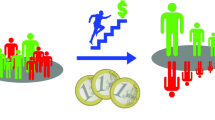Abstract
We consider the ideal-gas models of trading markets. where each agent is identified with a gas molecule and each trading an as alastic or money-conserving (two-body) collision. Unlike in the ideal gas. we introduce saving propensity λ of agents, such that each agents saves a fraction λ of its money and trades with the rest. We show the steady-state money or wealth distribution in a market is Gibbs-like for λ=0, has got a non-vanishing most-probable value for λ≠0 and Pareto-like when λ is widely distributed among the agents. Wr compare these results with observations on wealth distributions of various countries
Access this chapter
Tax calculation will be finalised at checkout
Purchases are for personal use only
Preview
Unable to display preview. Download preview PDF.
Similar content being viewed by others
References
Second Nikkei Econophysics Symposium (2002) homepage: http://weh.nikker.co.jp/sae/sae
Stanley H E et al (1996), Anomalous Fluctuations in the Dynamics of Complex Systems: From DNA and Physiology to Econophysics, Physica A 224; 302–321
Statphys-Kolkata I-IV: Frocs. in Physica A 186: (1 & 2) (1992) I; Physica A 224: (1 & 2) (1996) II; Physica A 270:(1 & 2) (1999) III; Physica A 318: (1 & 2) (2003) IV
Proc. School on Complex Systems, Indi an J. Phys. B 69: 483–698
Chakrabarti B K, Marjit S (1995), Self-organisation in Game of Life and Economics, Indian J. Phys, B 69: 681–698
Moss de Oliveira S, de Oliveira P M C, Stauffer D (1999), Evolution, Money, War and Computers, Tuebner, Stuttgart, pp 110–111, 127
Dragulescu A A, Yakovenko V M (2000), Statistical Mechanics of Money, Euro. Phys. J. B 17: 723–726
Chakraborti A, Chakrabarti B K (2000), Statistical Mechanics of Money: Effects of Saving Propensity, Euro. Phys. J. B 17: 167–170
Hayes B (2002), Follow the Money, Am. Scientist, 90: (Sept-Oct) 400–405
Pareto V (1897), Le Cours d’Economique Politique, Lausanne & Paris
Chakraborti A (2002), Distribution of Money in Model Markets of Economy, arXiv:cond-rnat/0205221, to appear in Int. J. Mod. Phys. C 13 (2003)
Tsallis C (2003), An Unifying Concept for Discussing Statistical Physics and Economics, in this Proc. Vol.; Reiss H, Rawlings P K (2003) The Natural Role of Entropy in Equilibrium Economics, in this Proc. Vol.
Dragulescu A A, Yakovenko V M (2001), Evidence for the Exponential Distribution of Income in the USA, Euro. Phys. J. B 20: 585–589; Dragulescu A A, Yakovenko V M (2002), Statistical Mechanics of Money, Income and Wealth, arXiv: tond-mal /0211175
Fujiwara Y, Aoyama H (2003), Growth and Fluctuations of Personal Income I & II, in this Proc.. Vol., arXiv:cond-mat/0208398
Chakraborti A, Pradhan S, Chakrabarti B K (2001), A self-organising Model Market with single Commodity, Physica A 297: 253–259
Chatterjee A (2002) unpublished; Chatterjee A, Chakrabarti B K, Manna S S (2003), Pareto Law in a Kinetic Model of Market with Random Saving Propensity, arXiv: coed-mat/0301289.
Author information
Authors and Affiliations
Editor information
Editors and Affiliations
Rights and permissions
Copyright information
© 2004 Springer Japan
About this paper
Cite this paper
Chakrabarti, B.K., Chatterjee, A. (2004). Ideal Gas-Like Distributions in Economics: Effects of Saving Propensity. In: Takayasu, H. (eds) The Application of Econophysics. Springer, Tokyo. https://doi.org/10.1007/978-4-431-53947-6_40
Download citation
DOI: https://doi.org/10.1007/978-4-431-53947-6_40
Publisher Name: Springer, Tokyo
Print ISBN: 978-4-431-67961-5
Online ISBN: 978-4-431-53947-6
eBook Packages: Springer Book Archive




